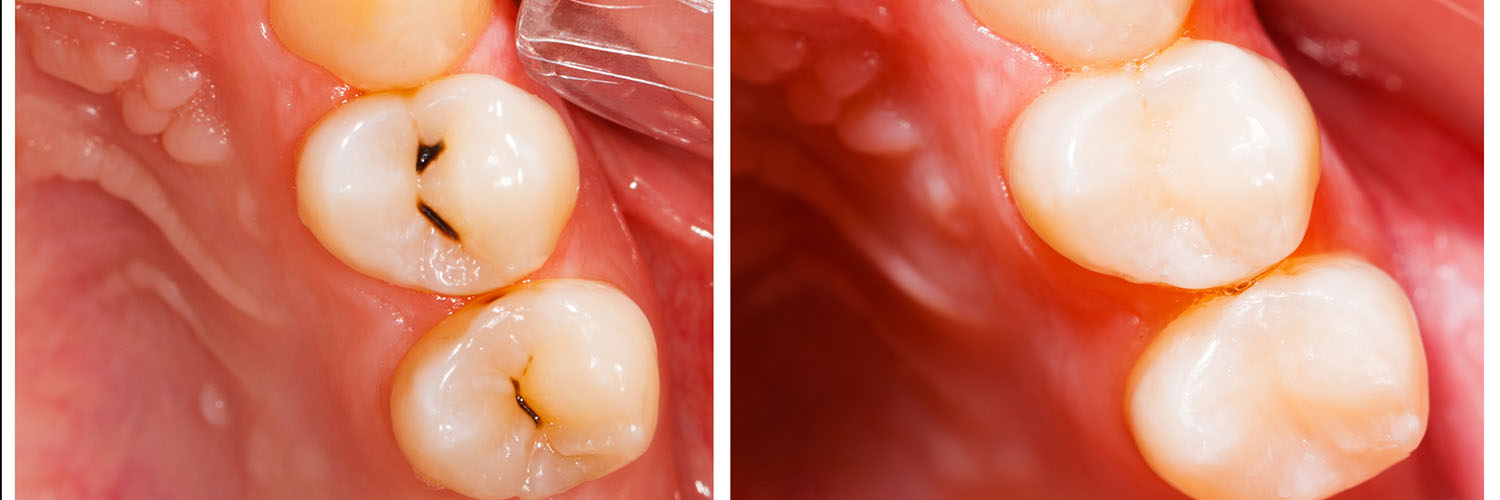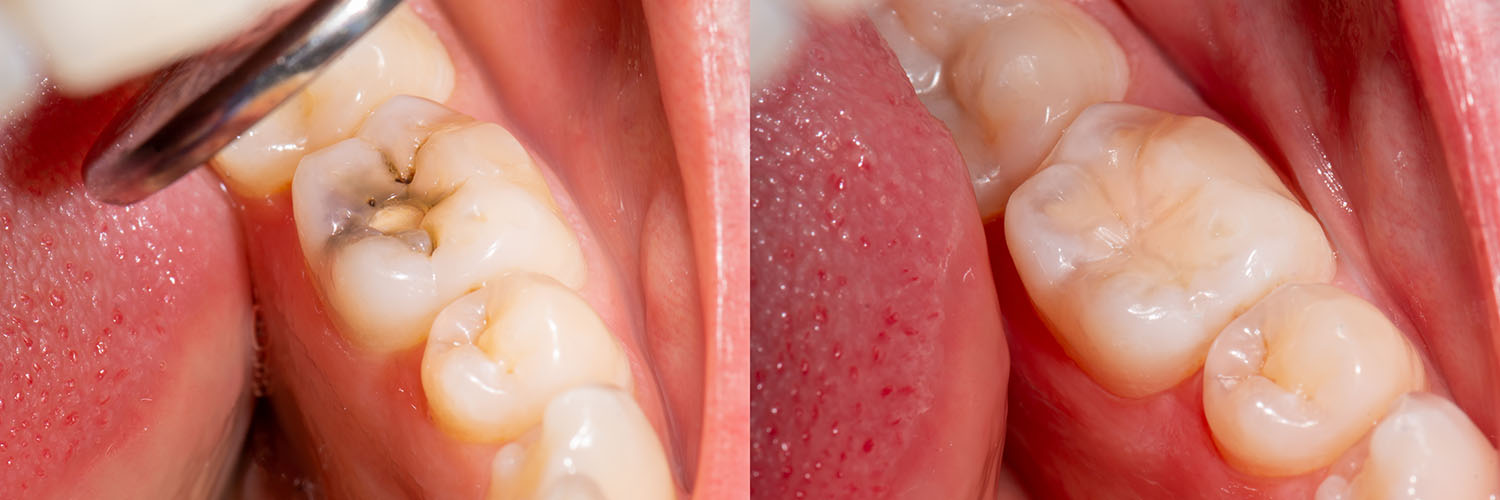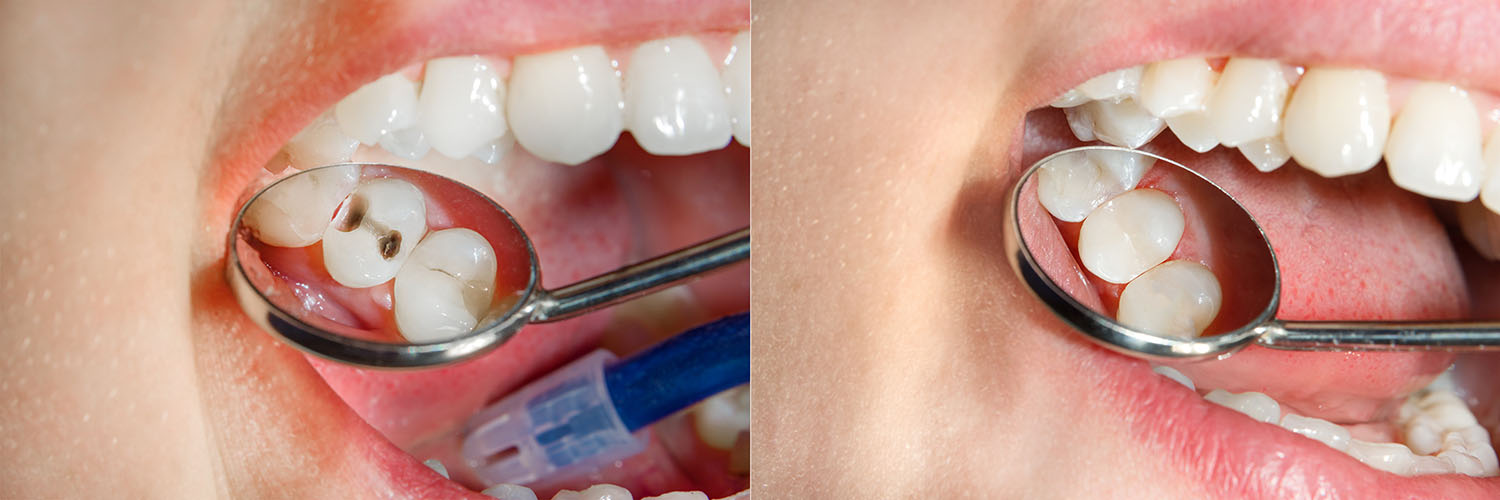Call Today
(908) 852-3693

When tooth enamel and dentin are broken down by decay, a carefully placed filling rebuilds the tooth so it can withstand normal chewing and look natural in your smile. Fillings are among the most common restorative treatments in dentistry because they address the problem early and preserve as much healthy tooth structure as possible.
Advances in materials and techniques mean fillings today do far more than simply fill a hole. They can bond to remaining tooth tissue, reinforce weakened areas, and blend with surrounding teeth for an aesthetic result. The goal is always to return function and comfort while minimizing future risk.
At the office of Dr. Anthony Iuvone, DMD, we focus on conservative, evidence-based care. That means selecting the right material and technique for each situation and explaining your options so you can make informed decisions about your dental health.
Human attempts to repair damaged teeth date back millennia, but modern restorative dentistry began to take shape in the 19th and 20th centuries with the introduction of metallic restoratives like gold and amalgam. Those materials provided durability and helped countless people retain natural teeth longer.
Over the past several decades, development of resin-based composites, ceramics, and glass ionomer cements has transformed how dentists approach restorations. These newer materials offer improved aesthetics and tooth-conserving bonding techniques that were previously unavailable.
Our philosophy centers on preserving tooth structure whenever possible and choosing treatments that balance longevity with appearance. We start with a thorough exam and patient conversation, explain the reasoning behind a recommended restoration, and tailor the procedure to your needs and comfort level.
Technology plays a role in every step: from accurate diagnosis to minimally invasive preparation and precise placement of the filling. We combine proven materials with careful technique so your restored tooth functions reliably and looks natural.

There is no single “best” filling material for every situation. The choice depends on the size and location of the cavity, the amount of remaining tooth structure, your bite forces, aesthetic priorities, and longevity expectations. We’ll walk you through the advantages and trade-offs of each option so you can weigh what matters most.
For small to moderate cavities in visible areas, tooth-colored materials that bond directly to the tooth are often preferred for their natural appearance. For large restorations or teeth that endure heavy chewing forces, indirect options fabricated from porcelain or gold may be considered for durability.
Patient habits and oral environment also influence material selection. People who grind their teeth, for example, may require a more wear-resistant restoration or protective measures after treatment. Our recommendations always reflect a balance between function, strength, and cosmetic outcome.
Composite fillings are made from a blend of resin and finely ground glass-like particles. They are available in a range of shades to match your teeth and bond directly to the remaining tooth, which helps support and seal the repair. Composites are versatile and commonly used for front and back teeth when preserving appearance is important.
Because composites are placed in layers and cured with a specialized light, they allow conservative preparation and can often be completed in a single visit. With good oral hygiene and routine care, composite restorations provide a reliable, aesthetic solution.
Amalgam has a long track record of strength and durability, particularly in large posterior fillings where chewing forces are greatest. While not tooth-colored, amalgam remains a practical choice in specific clinical circumstances because of its wear resistance and longevity.
Glass ionomer materials bond chemically to tooth structure and gradually release fluoride, which can help protect vulnerable areas from future decay. These are commonly used for baby teeth, cavities near the gum line, or as temporary restorations when a longer-term solution is planned.
Ceramic restorations, typically fabricated outside the mouth and bonded into place, offer excellent aesthetics and superior resistance to staining and wear. They are an excellent choice for larger repairs where a direct filling might not provide sufficient strength or longevity.
Gold remains one of the most durable restorative materials and is well tolerated by oral tissues. While less common today due to cosmetic preferences and cost, gold inlays and onlays continue to be a highly effective option for long-term function in select cases.

When we identify decay, the goal is to remove diseased tissue and restore the tooth promptly to prevent progression. Your appointment will begin with an exam and discussion of findings so you understand why a filling is recommended and which materials are appropriate.
Most restorations can be completed in one appointment. The procedure typically includes numbing the area with local anesthesia, gently removing decay with a drill, laser, or air abrasion tool, and preparing the tooth for the chosen material. Bonded materials are placed in layers and cured; indirect restorations may require a second visit for final seating.
We prioritize patient comfort throughout the process. If you feel anxious about dental procedures, we can discuss options for reducing stress and improving comfort, including nitrous oxide or other sedation techniques when appropriate.
After placement, we carefully check your bite and make any needed adjustments so your restored tooth feels natural. We’ll review post-procedure care and answer any questions before you leave the office.
Some temporary sensitivity after a filling is normal—teeth can react to temperature changes, pressure, or the bonding process itself. This usually settles within a few days to a couple of weeks. We advise patients to avoid very hard or sticky foods for a short time and to be mindful while the anesthesia wears off.
Good daily oral hygiene—brushing twice a day with fluoride toothpaste, cleaning between teeth, and keeping regular dental visits—helps extend the life of any restoration. Fillings don’t last forever; wear, new decay, and changes in the tooth can eventually require repair or replacement.
If you notice persistent pain, a sharp bite, rough edges, or a change in how the tooth feels, contact the office so we can evaluate the restoration. Timely attention to small concerns often prevents larger problems later on.
Important aftercare reminders:
Protect the numb area
After your appointment you may be numb for a short time. Take care not to bite your cheeks, lips, or tongue until sensation returns. Avoid hot drinks and hard foods until you are fully comfortable.
Expect minor adjustment needs
It’s normal to feel the restoration at first; we can make small refinements if your bite feels uneven or if you detect a high spot when chewing.
Temporary sensitivity is common
If you feel sensitivity to hot, cold, or pressure that lingers beyond a couple of weeks, please arrange an evaluation so we can determine whether further treatment is needed.
Maintain home care and routine checkups
Routine exams and cleanings help us monitor restorations and catch any new issues early, keeping your smile healthy for the long term.
We are committed to clear communication and careful dentistry. If you have questions after your appointment, our team is available to guide you through recovery and ongoing care.

In summary, dental fillings are a reliable, minimally invasive way to restore the form and function of teeth affected by decay. With modern materials and careful technique, restorations can be both durable and natural-looking. If you have questions about which option is best for your situation or would like more information, please contact us for a consultation.
If the pleasure of eating a delicious bowl of ice cream or sipping a soothing cup of tea gets overshadowed by dental pain that makes you wince; it's time to contact our office. As skilled providers of care, we'll determine what's causing your discomfort and perform the treatment required to alleviate your symptoms and get you back on the road to oral health.
Cavities develop because of an infectious process that causes progressive damage to tooth structure. Despite starting as a pinpoint defect on the outermost enamel layer of your tooth, untreated dental decay progressively compromises more and more healthy tooth structure as it works its way to the inner layers of your tooth.
Yes, you can still develop tooth decay on other surfaces of the tooth, around the margins of an old filling, or in fewer instances, recurrent decay underneath it. For this reason, it's essential to maintain excellent oral hygiene, a diet low in sugary beverages and sweets, and be sure to visit our office for routine checkups and care. While tooth decay is second only to the common cold in frequency, it's almost entirely preventable.
We value the time and comfort of our patients. If cavities are located on adjacent teeth, or in the same section of your smile, it may be possible to treat more than one tooth during your visit. However, how much is done each visit depends on several factors. We keep our patients well informed and tailor every treatment plan and visit to address their unique needs.
Addressing concerns on the presence of elemental mercury in silver fillings, the American Dental Association (ADA), The Center for Disease Control and Prevention (CDC), the FDA, and the World Health Organization have all stated that amalgam restorations do not pose a risk to health. However, individuals with allergies or sensitivities to the metals in dental amalgam are advised to pursue other restorative options.
Dental fillings are performed under local anesthesia to help ensure your comfort throughout the entire procedure. The involved tooth remains completely numb for the extent of your visit. Within one or two hours after the procedure is completed, the local anesthetic will gradually wear off, and normal sensations return.
A tooth-colored composite filling is fully hardened and set by the end of your visit. However, we may advise you to wait a couple of hours until the local anesthesia has completely worn off. This advice is to help ensure you don't accidentally bite your lip, cheek, or tongue while still numb.
The lifetime of a dental filling varies depending on the type of material used. While popular dental materials can last a decade or more with proper care, they can degrade over time, wear down, or even break. When this happens, you may experience some tooth sensitivity, a jagged edge, or a loose or dislodged piece of filling material. Whatever the case may be, it's essential to get the filling replaced before the tooth sustains further damage or other consequences arise. Beyond taking good care of your smile to help ensure the longevity of your fillings, our office regularly checks the status of your existing fillings as part of a routine checkup exam.
Dental fillings are an essential investment that serves to preserve and protect the health of your smile. With that said, how much a filling costs depends on the number of surfaces of the tooth involved and the filling material that is used. Amalgam restorations are the most economical. While tooth-colored composite fillings have a slightly higher cost, they offer the added benefits of being metal-free and much more aesthetically pleasing. Ceramic fillings, inlays, and onlays are more expensive than the preceding options but provide outstanding, long-lasting, and natural-looking results.
Dental insurances typically cover the cost of dental fillings. While we work with you to maximize your insurance benefits, there may still be an out-of-pocket expense. At the office of Dr. Anthony Iuvone, DMD, we strive to help you begin care without any additional financial stress or delay.
Dental fillings are restorations used to repair teeth damaged by decay or minor fracture so the tooth can function normally. The dentist removes diseased or weakened tissue and replaces it with a material that rebuilds the tooth’s shape and strength. The goal is to stop decay, restore chewing function, and preserve as much healthy tooth structure as possible.
Modern fillings often bond to the remaining tooth, which helps reinforce weakened areas and create a tight seal against bacteria. Many contemporary materials also mimic the color and texture of natural enamel for a more discreet result. Properly placed fillings restore comfort and reduce the risk of further damage when combined with good home care.
There are several common restorative materials including tooth-colored composite resins, amalgam, glass ionomer cements, ceramic inlays/onlays, and gold restorations. Composite resins bond to tooth structure and offer excellent aesthetics, while amalgam is known for durability in high-stress back teeth. Glass ionomers release fluoride and are useful in certain clinical situations, and indirect materials such as ceramics or gold are fabricated outside the mouth for larger repairs.
Each material differs in appearance, wear resistance, bonding characteristics, and how conservatively the tooth must be prepared. Direct materials like composites are placed and cured in a single visit, whereas indirect options require laboratory fabrication and precise bonding. Your dentist will explain the trade-offs so you can weigh function, longevity, and cosmetic priorities.
The choice of material depends on the size and location of the cavity, the amount of remaining tooth structure, and the forces the tooth will endure during chewing. Your dentist also considers aesthetic priorities, habits such as tooth grinding, and the overall condition of the mouth when recommending a restoration. A careful exam and discussion help match the material to your clinical needs and personal preferences.
At the office of Dr. Anthony Iuvone, DMD we emphasize conservative, evidence-based recommendations so you understand why a particular option is suggested. Where appropriate we balance longevity and appearance, and we discuss protective measures that may extend the life of the restoration. The result is a tailored plan that reflects both dental health and cosmetic goals.
A typical appointment begins with an exam and discussion of the findings so you understand why a filling is recommended and which materials are appropriate. Once you and the dentist agree on a plan, the area is numbed with local anesthesia and the decay or damaged tissue is gently removed using drills, air abrasion, or lasers as appropriate. The tooth is then prepared to receive the chosen material, and direct restorations are placed in layers and cured for strength.
After the filling is shaped and polished, the dentist carefully checks and adjusts your bite so the restored tooth feels natural. Indirect restorations may require an impression and a second visit for final seating after laboratory fabrication. Throughout the visit we prioritize comfort and clear communication about aftercare and expected sensations.
Local anesthesia is commonly used during filling procedures, so it is normal to experience numbness in the treated area for a short period after your appointment. During this time you should avoid chewing or touching the area with your lips or tongue to prevent accidental biting. The anesthesia typically wears off within a few hours depending on the medication used and individual metabolism.
Some temporary sensitivity to hot, cold, or pressure is common after a filling and often subsides within a few days to a couple of weeks. If sensitivity persists beyond that timeframe or you experience sharp pain, it is important to schedule an evaluation so the dentist can determine whether an adjustment or further treatment is needed. Prompt attention to ongoing symptoms helps prevent more extensive problems.
The lifespan of a filling varies widely depending on the material, the size and location of the restoration, and the forces placed on the tooth. Factors such as oral hygiene, diet, bruxism (teeth grinding), and routine dental checkups all influence how long a restoration remains intact. While some restorations last many years with proper care, no filling is permanent and wear or recurrent decay may eventually require repair or replacement.
Regular dental exams and cleanings allow your dentist to monitor restorations and catch early signs of wear or breakdown. Protective measures like night guards for grinders or adjustments to chewing patterns can extend the life of restorations. Maintaining consistent home care and following professional recommendations are the best ways to maximize longevity.
Inlays, onlays, and crowns are indirect restorations that are often recommended when a cavity is large, the remaining tooth structure is compromised, or a stronger long-term solution is needed. These restorations are fabricated in a laboratory from materials such as ceramic or gold and are bonded to the tooth for superior strength and durability. They preserve more of the natural tooth than full crowns in some cases and can provide improved resistance to fracture compared with large direct fillings.
Your dentist will evaluate the extent of damage, your bite forces, and aesthetic goals when suggesting an indirect restoration. Choosing an inlay, onlay, or crown can reduce the risk of future failure and provide a more predictable outcome for teeth that sustain heavy chewing loads. A clear explanation of the benefits and treatment sequence helps you decide which option best suits your needs.
Minor chips, rough edges, or localized wear can sometimes be repaired with a conservative approach that preserves the majority of the existing restoration and tooth. The dentist will assess the extent of damage using visual exam and imaging to determine whether an in-office repair, a replacement filling, or an indirect restoration is needed. Conservative repairs are preferable when feasible because they avoid unnecessary removal of healthy tooth structure.
If a filling shows signs of recurrent decay, persistent sensitivity, or structural failure, replacement is often the most appropriate option to restore long-term function. Early evaluation of small problems often prevents more extensive treatment later on. If you notice a change in how a tooth feels or see a visible defect, contact the office for an assessment so the issue can be addressed promptly.
Good oral hygiene is the foundation for extending the life of any filling: brush twice daily with fluoride toothpaste, clean between teeth daily, and keep regular dental visits for professional cleaning and monitoring. Avoiding frequent sugary snacks and acidic beverages reduces the risk of new decay forming at the margins of restorations. If you have habits that stress teeth, such as nail biting or chewing ice, changing those behaviors can also protect restorations.
If you grind or clench your teeth, wearing a custom night guard can dramatically reduce wear on fillings and natural tooth structure. During routine exams your dentist will check for wear, marginal breakdown, or recurrent decay so any needed maintenance can be performed early. Following personalized recommendations from your dental team helps preserve both the filling and the overall health of the tooth.
Fillings are monitored during routine dental exams using visual inspection, bite assessment, and dental x-rays when indicated to detect recurrent decay or structural changes. Common signs that warrant evaluation include persistent or worsening sensitivity, a noticeable change in bite, rough or sharp edges, and visible cracks or discoloration around the restoration. Early detection allows the dentist to recommend conservative repairs or replacements before a minor issue becomes more extensive.
Maintaining scheduled checkups gives your dentist the opportunity to track how restorations are performing and to provide preventive guidance tailored to your needs. If you experience any new symptoms or sudden changes in a filled tooth, contact the office so the restoration can be assessed and any necessary care can be arranged. Timely attention helps protect the tooth and maintain your oral comfort and function.
